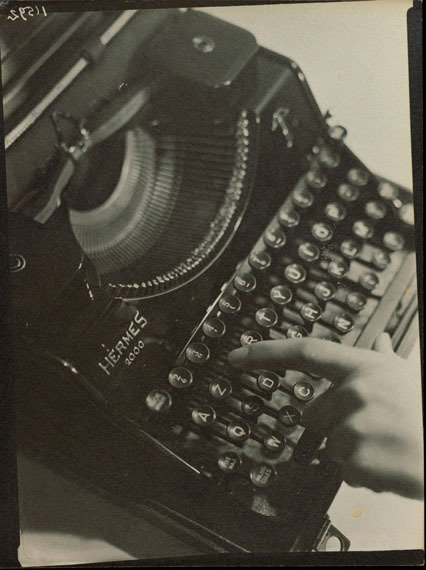Paul-Martial's World of Ordinary Things
dal 3/7/2014 al 18/10/2014
Segnalato da
3/7/2014
Paul-Martial's World of Ordinary Things
Kunstmuseum Basel, Basel
Newly acquired photographs from the Herzog Collection. The exhibition presents a selection of 100 photographs made between the late 1920s and the 1960s. They present the sober aesthetic of the New Objectivity, which took hold after the Great War.

Curator: Anita Haldemann
The Kunstmuseum Basel opens a new exhibition presenting a selection of one hundred photographs from the archives of the Paris-based advertising agency Éditions Paul-Martial. The black-and-white pictures formed the basis for posters, newspaper advertisements, and brochures and show ordinary things: buildings, cars, typewriters, radiators, mannequins. What was unusual and novel, however, were the composition, lighting, and exposure of the pictures. In today’s perspective, the collection reflects the multifaceted evolution of photography from the 1920s onward. At the same time, it is an invaluable source for historians, documenting early forms of the carefully designed presentation of commodities and strategies designed to lure the consumer. The photographs are part of a collection newly acquired from the Herzog Collection and have never been on public display.
Cans make it possible to preserve food for the long term; zippers allow bags and pockets to be securely closed; rubber soles protect the walker from slipping; car jacks make it easier to change a tire: the advertising photographs produced by Éditions Paul-Martial tell stories about everyday life and how products like radiators, boilers, and cooking stoves help make it more pleasant. This renders the collection an extraordinarily valuable resource for historians: it illustrates the early history of the staging of consumer goods and the strategies employed to seduce the viewer. Beyond consumer products, the agency’s photographers also captured the new worlds of work in factories and offices and the rise of modern travel and communication technologies. For the time being, most of the photographs’ creators remained anonymous; in the business perspective, individual authorship was obviously a secondary concern, especially since the majority of the pictures were a sort of intermediate product to be used by graphic artists in the design of brochures and posters.
New Objectivity and Neues Sehen The historic photographs also reflect the multifaceted evolution of photography as an art in its own right from the 1920s onward. Pictures of buildings, machines, and selected products hew to the sober aesthetic of the New Objectivity, which took hold after the Great War. Photographs of transformer stations and bridges point to the Neues Sehen (New Vision) of the Bauhaus photographers and the works of the Russian avant-garde, which emphasized diagonal lines to heighten the dynamic quality of the picture—this influence is also evident in techniques such as photomontage and double exposures. In isolated objects and enigmatic motifs such as a pinecone, the surreal, mysterious, and sometimes also absurd infiltrate the world of ordinary things. The photographers’ love of experimentation is palpable throughout: they often created small series in which they tried different lighting effects and unusual angles of view. The selection of a hundred photographs is drawn from a larger collection the museum acquired from the collection of Peter and Ruth Herzog, Basel, in 2012 through a combined purchase-and-donation agreement. The exhibition was designed in close collaboration between the curator, Anita Haldemann, and the photography collector and expert Peter Herzog.
The Herzog Foundation and the Fonds Paul-Martial
The Herzog Foundation’s collection of historic photographs is of eminent international significance. It is the fruit of four decades of dedicated efforts on the part of the collectors Peter and Ruth Herzog. In 2002, the Herzogs established the Herzog Foundation in order to create a forum for ca. 300,000 photographs, foster public interest in the collection’s holdings, and build a discursive framework for the presentation of their treasures. The extensive collection of samples and the reference library at Ruth and Peter Herzog’s Laboratory of Photography now enable interested scholars and laypeople to engage in extensive studies in the history of international photography (visit www.fondation-herzog.ch for more information). The Fonds Paul-Martial—considerable parts of its inventory have also gone to the Musée d’Art Moderne de Saint-Étienne Métropole, the department of prints and photography at the Bibliothèque nationale de France, and the collection of Marc Pagneux, France—is still widely unknown, and the work of exploring this exceptionally rich archive, which promises important insights into the history of photography and especially of contemporary art, has only just begun.
Colloquium at the Kunstmuseum
A one-day scholarly colloquium on the photographs of the Éditions Paul-Martial will be held at the Kunstmuseum on August 8, 2014. Please visit www.kunstmuseumbasel.ch for our complete program of events.
Image: Anonymous Commercial Photography, 1933, Éditions Paul-Martial, Paris © Kunstmuseum Basel
Media contact
Michael Mathis Tel. +41 61 2066280, michael.mathis@bs.ch
Opening: Friday, July 4, 7:30pm
Kunstmuseum Basel
St. Alban-Graben 8, CH-4010 Basel
Hours:
Tue,Thu-Sun 10am-5pm, Wed 10am-8pm
Admission Collection and temporary exhibition:
Adults CHF 15 / EUR 13 |
reduced CHF 8 / EUR 7,
visitors below the age of 14 are admitted for free



